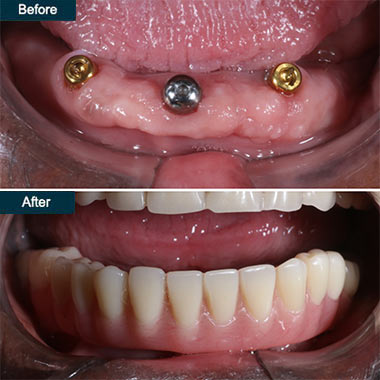Table of contents
Using dentures to replace missing teeth allows them to enjoy a better diet and to smile confidently.
A denture is made from acrylic and is sometimes strengthened with a lightweight metal called cobalt chrome.
There are two main types of dentures:
Modern dentures are very different from teeth you may remember older relatives wearing in the past. The teeth used in modern dentures look incredibly lifelike, and there is an amazing choice available.

You may want to opt for the highest quality denture teeth if aesthetics are particularly important, as these can look fabulous. Also, an experienced cosmetic dentist working closely with a dental laboratory can make sure that the teeth are arranged in the denture in such a way, so they look very natural.
Properly made dentures support the facial muscles, filling out your face and creating a more youthful appearance.
You will also have your say in how your new dentures look, so for example, if you have a feature in your current smile that you’d like to replicate, such as a gap between your front teeth, this can easily be done in your new denture.
Alternatively, you may take this opportunity to perfect your smile with denture teeth that are beautifully aligned. Your local dentist will also want to make sure that your dentures support your facial structure correctly. All too often, people who are missing all or most natural teeth have facial features that begin to sag inwards.
One major and quite understandable fear amongst people who are about to lose teeth is whether they will be left without teeth until a denture is made.
This isn’t the case as a dentist can fabricate what’s called an immediate denture made before your teeth are removed and fitted soon afterward. It ensures that you are not left without teeth, and you wear the immediate denture while your gums heal.
It’s important to have an immediate denture initially because your gums and the bone underneath will change significantly and will begin to shrink during the healing stage.
It can take around six months for healing to finish, and during this time, your immediate dentures may need relining to ensure they continue to fit comfortably. Once your gums and bone have healed, your dentist can make a more permanent denture.
The process of making well-fitting dentures requires several visits to your dentist. They will need to take precise measurements of your mouth using dental impressions. The dentist may use a bite block, a block of wax that fits over your gums and registers your facial dimensions.
The block records the height between your upper and lower jaws and the approximate position of your facial features so denture teeth can be properly aligned.
During this appointment, your dentist will select your new denture teeth with you and can guide you on the features to complement your facial features, such as:
The dental laboratory uses this information to make a wax denture initially. A wax base supports your new denture teeth and replicates your gums, and once ready, it is tried in by your dentist during your next appointment.
At this stage, you will see how your new denture will look, and you will get a good idea of how it will feel. Because the denture teeth are still set into wax, your dentist can easily make changes to the arrangement of the teeth, helping to ensure that they fit together properly and feel and look good.
Once you are happy with the appearance and your dentist is happy with the fit and function, the wax denture is returned to the dental lab. They replace the wax with gum-colored acrylic and polish and finish the denture.
When the dentures are ready, you will have another appointment to have them properly fitted by your dentist. Usually, your dentist will want to see you a week or so later to make any small adjustments to the denture’s fit as you get accustomed to wearing it.
Like any new dental appliance, wearing a new denture can take a little getting used to, and you may need to practice eating and speaking. When you first eat with your new denture, choose softer foods and cut them into smaller pieces.
Chew your food using both sides of your mouth as this will help keep the denture more stable. Gradually, you can start adding more foods to your diet as you become accustomed to eating with a denture.
When it comes to speaking, you may find certain words are harder to pronounce or that your dentures slip out of place if you cough, laugh or smile. You can reposition them by gently biting down while swallowing. The problem should disappear as your facial muscles get used to your new dentures, but if it continues, see your dentist.
Most people find dentures easy to get used to wearing, but if yours cause you difficulty or distress, see your dentist about dental implants instead. Dental implants can support a denture that will clip onto the implants firmly and which cannot move out of place.
Another alternative is to get rid of the denture entirely and have an implant bridge permanently fitted onto the dental implants. Your dentist can discuss all options that might be suitable for your needs.